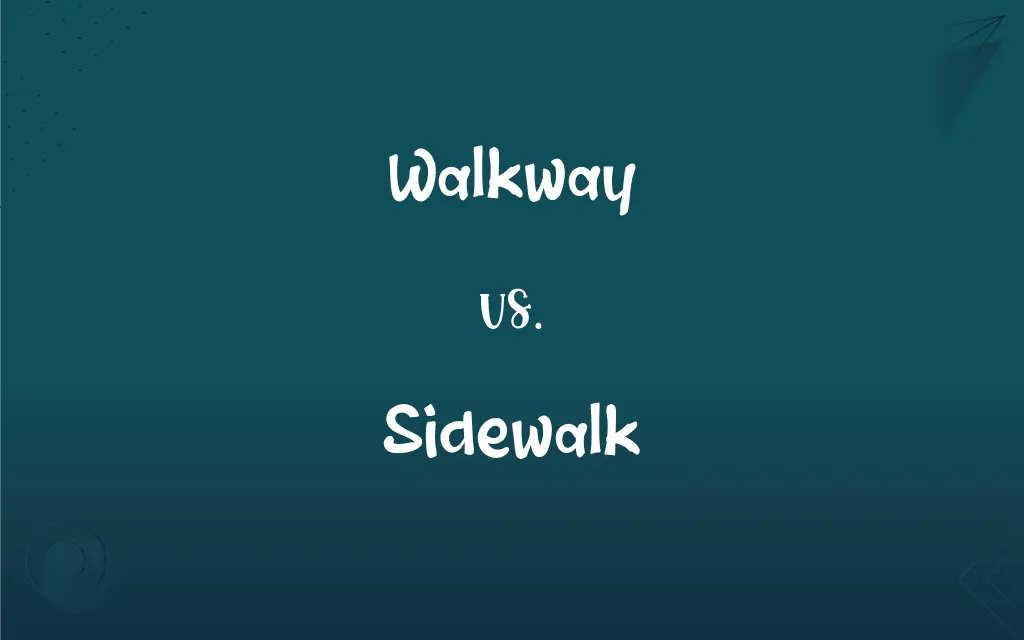Walkway vs. Sidewalk: What's the Difference?
By Harlon Moss || Updated on May 22, 2024
A walkway is a path designed for pedestrian use, often in parks or gardens, while a sidewalk is a paved path alongside a road for pedestrian use.

Key Differences
A walkway refers to any path designated for pedestrians, typically found in various environments such as parks, gardens, or campuses. Walkways can be made of various materials, including gravel, wood, or pavement, and are designed to enhance the pedestrian experience within a specific setting. On the other hand, a sidewalk is a paved path alongside a road, providing a safe space for pedestrians in urban and suburban areas. Sidewalks are usually made of concrete or asphalt and are an essential part of city infrastructure to ensure pedestrian safety and accessibility.
Walkways can be found in both natural and urban settings, often winding through scenic areas to connect different points of interest. They can vary in design, width, and surface material, catering to different types of pedestrian traffic. Sidewalks, however, are typically uniform in design, running parallel to streets and providing a consistent and safe route for pedestrians.
Walkways may include additional features such as benches, lighting, and landscaping to enhance the pedestrian experience. In contrast, sidewalks focus more on functionality and safety, often including features like curbs and ramps to accommodate various users, including those with disabilities.
Walkways can be leisurely, inviting strolling or recreational walking, while sidewalks are primarily utilitarian, facilitating efficient pedestrian movement in busy areas. Sidewalks are mandated by urban planning regulations to ensure pedestrian safety and are usually maintained by local governments.
Comparison Chart
Location
Parks, gardens, campuses
Alongside roads
ADVERTISEMENT
Material
Gravel, wood, pavement
Concrete, asphalt
Purpose
Recreational, scenic walking
Safe pedestrian path
Design Variation
Varied, scenic
Uniform, functional
Additional Features
Benches, lighting, landscaping
Curbs, ramps, crosswalks
Walkway and Sidewalk Definitions
Walkway
A passage or path for walking, often scenic or recreational.
The walkway along the river is perfect for an evening stroll.
ADVERTISEMENT
Sidewalk
A paved path alongside a road for pedestrians.
The new sidewalk ensures children can walk safely to school.
Walkway
A path designed for pedestrians in various environments.
The garden features a beautiful gravel walkway winding through the flowers.
Sidewalk
Typically made of concrete or asphalt.
The city is repairing the cracked sidewalk on Main Street.
Walkway
A pedestrian path in parks, campuses, or private properties.
Students used the walkway to move between campus buildings.
Sidewalk
Essential part of urban infrastructure for pedestrian safety.
Sidewalks are cleared of snow to keep them usable in winter.
Walkway
Can be made of various materials like wood, stone, or pavement.
The wooden walkway through the forest offers a serene walk.
Sidewalk
Provides a safe route for pedestrians in urban and suburban areas.
The sidewalk is wide enough for pedestrians and cyclists.
Walkway
Often includes additional amenities like benches and lighting.
The well-lit walkway in the park is safe for night-time walks.
Sidewalk
Often includes features like curbs and ramps for accessibility.
The sidewalk has ramps to accommodate wheelchairs.
Walkway
A passage or path for walking, especially one that is roofed, paved, or elevated above its surroundings.
Sidewalk
A paved walkway along the side of a street.
Walkway
A clearly defined path for pedestrians.
Sidewalk
(US) (usually) a paved footpath located at the side of a road, for the use of pedestrians
Walkway
A path set aside for walking;
After the blizzard he shoveled the front walk
Sidewalk
Any paved footpath, even if not located at the side of a road
Sidewalk
A walk for foot passengers at the side of a street or road; a foot pavement.
Sidewalk
Walk consisting of a paved area for pedestrians; usually beside a street or roadway
FAQs
Where are walkways typically found?
Walkways are typically found in parks, gardens, campuses, and other scenic or recreational areas.
Do walkways have additional features?
Yes, walkways often include features like benches, lighting, and landscaping.
Do sidewalks have curbs?
Yes, sidewalks typically have curbs to separate them from the road.
What materials are used for sidewalks?
Sidewalks are usually made of concrete or asphalt.
Are walkways always paved?
No, walkways can be unpaved and made of materials like gravel or wood.
What is a sidewalk?
A sidewalk is a paved path alongside a road for pedestrian use.
Is a sidewalk part of urban infrastructure?
Yes, sidewalks are a crucial part of urban infrastructure for pedestrian safety.
Do walkways need maintenance?
Yes, like all paths, walkways require regular maintenance to remain safe and usable.
What is a walkway?
A walkway is a path designed for pedestrian use, often found in parks, gardens, or campuses.
Can a walkway be scenic?
Yes, walkways are often designed to be scenic, providing a pleasant walking experience.
Are sidewalks required by law?
Yes, sidewalks are often mandated by urban planning regulations for pedestrian safety.
What is the main purpose of a sidewalk?
The main purpose of a sidewalk is to provide a safe path for pedestrians alongside roads.
What is the difference between a walkway and a footpath?
The terms are often used interchangeably, but walkways can be more scenic, while footpaths are typically more functional.
Are walkways common in residential areas?
Yes, walkways can be common in residential areas, especially within parks or community gardens.
Can walkways be made of gravel?
Yes, walkways can be made of gravel, wood, pavement, or other materials.
Can sidewalks have bike lanes?
Yes, some sidewalks include bike lanes for cyclists.
Is a boardwalk considered a walkway?
Yes, a boardwalk is a type of walkway typically found along beaches or waterfronts.
Are sidewalks maintained by local governments?
Yes, sidewalks are usually maintained by local governments.
Can a walkway be used for jogging?
Yes, walkways can be used for jogging, walking, and other recreational activities.
Do sidewalks accommodate people with disabilities?
Yes, sidewalks often include features like ramps to accommodate people with disabilities.
About Author
Written by
Harlon MossHarlon is a seasoned quality moderator and accomplished content writer for Difference Wiki. An alumnus of the prestigious University of California, he earned his degree in Computer Science. Leveraging his academic background, Harlon brings a meticulous and informed perspective to his work, ensuring content accuracy and excellence.































































